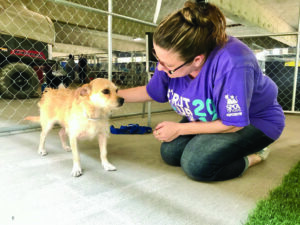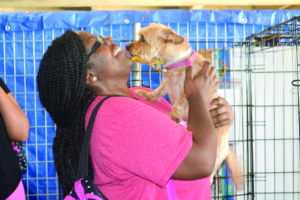By Dr. Beth Leermakers
Want to save a life? Foster a dog, cat, bunny or other animal. City shelters throughout Texas (that must accept incoming strays and owner surrenders) are beyond full. Fort Worth Animal Care and Control recently took in more than 400 dogs in one week, and Dallas Animal Services often has similar intake.

Photos courtesy of the SPCA of Texas
When there aren’t as many animals leaving (by being reclaimed, adopted, fostered or rescued) as arriving, shelter staff must euthanize healthy, adoptable animals to make room for new ones. North Texas shelters and rescue groups desperately need foster homes to save lives. Rescue groups cannot save animals without having somewhere to keep them while they look for a forever home. Boarding is expensive and not a good long-term solution.
Fostering isn’t easy (although sometimes you get lucky with an easy dog), but it is highly rewarding seeing a scared, skinny dog blossom into a confident, healthy one. Fostering is rarely completely free, but the shelter or rescue group should provide heartworm and flea preventatives and cover vaccinations, heartworm treatment (if needed) and other medical expenses. Some rescue groups provide food, treats, toys, beds and loaner crates. Ask what supplies the rescue group (or shelter) will give you.
I’ll share a few tips to make fostering a dog as stress-free as possible. Several rescue groups mentioned below (short term foster opportunities) also need foster homes for cats, so please skip to that section if you’re a cat person. The rescue volunteers can provide guidance on fostering a cat.
What you’ll need to
foster a dog:
A place to keep the dog separate from your personal pets for the first week or so.
• Spare bedroom
• Laundry room
• Guest bathroom
If you can’t close a door, you can use baby gates to block off the foster dog’s crate.
Vaccinations. Be sure your personal dogs are current on their rabies, DAPP (distemper and parvovirus) and Bordetella (kennel cough) vaccinations.
A crate. Some rescue groups provide loaner crates. If not, you can purchase a sturdy two-door metal crate at Hollywood Feed (good quality at an affordable price), other local pet stores, or Amazon (check out the Midwest Pets Life Stages crates).
A sturdy slip leash. Slip leashes prevent the dog from slipping out of his collar. The foster dog should have a collar provided by the shelter or rescue group. If not, a martingale collar tightens when you pull on the (regular) leash, so the dog can’t back out of the collar.
A foster ID tag. Purchase a metal ID tag (or embroidered collar) that says, “Foster dog” and your phone number. Your foster dog may be microchipped, but it is much quicker and easier for someone to call you directly if they find your dog.
Food. If the rescue group doesn’t provide food (some do), you’ll want a high-quality food (for better health, coat/skin and less poop) at a good price. Check dogfoodadvisor.com for food that has meat listed as the first ingredient and doesn’t have corn, artificial preservatives and other poor-quality ingredients. The Kirkland (Costco brand) kibble is high quality at a great price.
Decompression Period
Giving your new foster dog time (usually at least seven days) to decompress from shelter stress is important. Keep the new dog separate from your dogs and cats to give the foster dog time to relax and settle in — and prevent your dog from catching an upper respiratory Infection or other illness. I don’t let new foster dogs drink from the same water bowls used by my other dogs.
Introductions to Resident Dogs
After the seven day (or longer) decompression period, it’s time to slowly introduce your foster dog to your personal dog(s). By now they’ve all had a chance to smell each other (via urine in the yard) and see each other without getting too close. The next step is to do a parallel leash walk with two dogs (walked by separate people) at a time.
Start by walking the dogs on opposite sides of the street. Gradually move closer together, but don’t let the dogs touch yet. If one of the dogs becomes tense (tail tucked, hackles raised, growling or barking), move farther apart. Wait until they relax, and then gradually move closer together. It may take a few walks for the dogs to be comfortable together.

Next, move to the backyard. You need two people — one to hold each dog/leash. Gradually allow the dogs to move closer together and smell each other. If they’re relaxed, drop the leashes but leave them attached (in case you need to separate the dogs). If they play too roughly, calmly separate the dogs. If they’re getting along well, let the dogs spend five or 10 minutes together, and then separate them. Slow and steady is the way to go.
Can’t foster? Shelters and rescue groups need donations, volunteers, local transporters, and people to share social media posts. There are many ways to help.
Thank you for making a difference in a homeless pet’s life!
Shelters That Have Foster Programs
Dallas Animal Services. bedallas90.org/foster
Fort Worth Animal Care and Control.
app.betterimpact.com/PublicOrganization
Garland Animal Services.
frastx.org/volunteer.
Short-Term Foster Opportunities
Every rescue group needs foster homes. Several groups need short-term, temporary foster homes until the puppies or adult dogs are transported to rescue groups in other states (where foster homes or adopters are waiting for them).
If you (or your spouse) are concerned that you’ll get too attached to the dog and want to keep her, short-term fostering is a good way to start. Most rescue groups won’t let you adopt the dog because she already has an adopter waiting for her.
Here are a few rescue groups I’ve fostered for and recommend (due to providing excellent communication and support):
Passport for Paws. Dogs and cats need foster homes for a few days to a few weeks (or occasionally a couple months, if the dog needs heartworm treatment). Transport departs from Keller, but there are volunteers who can take your dog to transport drop off. passportforpaws.org.
The Street Dog Project. This group requests a commitment of 2 – 4 weeks for temporary fostering. Transport leaves from Dallas or sometimes the Denton airport. Again, volunteers can take your dog to transport drop off, if needed.
thestreetdogproject.org/fosterdog.
Mike’s Chance Animal Rescue. Cats and dogs need foster homes for one week to several weeks (or occasionally longer if the dog needs heartworm treatment).
mikeschanceanimalrescue.com/foster.htm
Highway Hounds. Dogs and cats need temporary foster homes for a few weeks. Transport departs from Fort Worth.
highwayhoundstx.org/fostering.
Society for Companion Animals. SFCA needs people to pick up a dog in Dallas, keep it overnight and take it to DFW airport for an early morning flight.
societyforcompanionanimals.org/how-you-can-help.
Can’t foster? Shelters and rescue groups need donations, volunteers, local transporters and people to share social media posts. There are many ways to help.
Thank you for making a difference in a homeless pet’s life!
